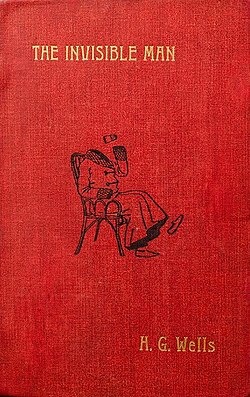Plot summary
A man named Griffin arrives at an inn owned by Mr. and Mrs. Hall of the English village of Iping, West Sussex, during a snowstorm. He wears a wide-brimmed hat, a long-sleeved, thick coat and gloves; his face is hidden entirely by bandages except for a prosthetic nose. He is reclusive, irascible, unfriendly, and introverted. He demands to be left alone and spends most of his time in his rooms working with chemicals and laboratory apparatus, only venturing out at night. He causes a lot of accidents, but when Mrs. Hall addresses this, Griffin demands that the cost of the damage be put on his bill. While he is staying at the inn, hundreds of glass bottles arrive. His odd behaviour becomes the talk of the village, with many theorizing as to his origins.
Meanwhile, a burglary occurs in the village, but no suspect is found. Running short of money, Griffin is unable to pay for his lodging and meals. When his landlady threatens to kick him out, he reveals his invisibility to her in a fit of anger. An attempt to apprehend him by the police is thwarted when he undresses to take advantage of his invisibility, fights off his would-be captors, and flees.
At the South Downs, Griffin coerces a tramp, Thomas Marvel, to become his assistant. With Marvel, he returns to the village to recover three notebooks that contain records of his experiments. Marvel attempts to betray Griffin, who threatens to kill him. Marvel escapes to the seaside town of Port Burdock, pursued to an inn by Griffin, who is shot by one of the bar patrons.
Griffin takes shelter in a nearby house that turns out to belong to Dr. Kemp, a former acquaintance from medical school. To Kemp, he reveals his true identity: an albino former medical student who left medicine to devote himself to the science of optics.
Griffin tells the story of how he invented chemicals capable of rendering bodies invisible, which he first tried on a cat, then himself, how he burned down the boarding house he was staying in to cover his tracks, found himself ill-equipped to survive in the open, stole clothes from a theatrical supply shop on Drury Lane, and then headed to Iping to attempt to reverse the invisibility. Having been driven insane by the procedure and his experiences, Griffin now imagines that he can make Kemp his secret confederate, describing a plan to use his invisibility to terrorise the nation.
Kemp has already denounced Griffin to the local authorities, led by Port Burdock's chief of police, Colonel Adye, and waits for help to arrive while listening to this wild proposal. When Adye and his men arrive, Griffin fights his way out and the next day leaves a note announcing that Kemp will be the first man to be killed in the "Reign of Terror". Kemp tries to organise a plan to use himself as bait to trap the invisible man, but a note that he sends is stolen from his servant by Griffin. During the chase, Griffin arms himself with an iron bar and kills a bystander. [2]
Griffin shoots Adye, then breaks into Kemp's house. Adye's constables fend him off and Kemp bolts for the town, where the locals come to his aid. Still obsessed with killing Kemp, Griffin nearly strangles him but is cornered, seized, and beaten by the enraged mob, his last words a cry for mercy. Kemp urges the mob to stand away and tries to save Griffin's life, though unsuccessfully. Griffin's battered body becomes visible as he dies. A policeman has someone cover Griffin's face with a sheet.
It is later revealed that Marvel has secretly kept Griffin's notes and—with the help of the stolen money— becomes a successful businessman, running the "Invisible Man Inn". However, when not running his inn, Marvel tries to decipher the notes, hoping of one day recreating Griffin's work. However, because pages were accidentally washed clean, and the remaining notes are coded in Greek and Latin, and Marvel has no comprehension of even the basic mathematical symbols he sees in the notes, this is unlikely. [2]
